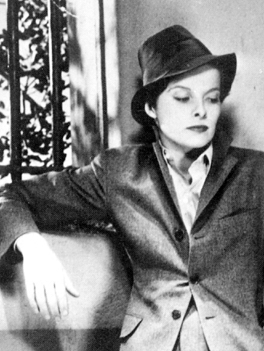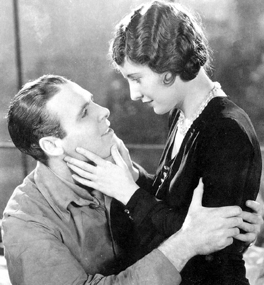
|
|
Vol. LXI, No. 22
|
|
Wednesday, May 30, 2007
|

|
|
Vol. LXI, No. 22
|
|
Wednesday, May 30, 2007
|

SYLVIA AS SYLVESTER: Possibly Katherine Hepburn's most magical performance was in "Sylvia Scarlett," a film both she and director George Cukor felt they had to apologize for; in fact, playing a girl disguised as a boy seemed to liberate her: she was antic and impish and full of life, and free of the precious mannerisms that marred some of her other performances. Many years later, in Princeton alum A. Scott Berg's "Kate Remembered," she calls it "awful." Don't take her word for it; it's a unique, unforgettable film, with a picaresque flavor and Cary Grant at his most spirited as a Cockney con man. |

"I WISH I'D BEEN BORN THIS MORNING": This is what Kay Arnold (Barbara Stanwyck) says when love, hope, and joy all come together for her in the person of a rich, wouldbe artist (Ralph Graves) in "Ladies of Leisure." What was actually being born in this scene was the star named Barbara Stanwyck. |
One of the landmark sequences in motion picture history comes at the end of Charlie Chaplin’s City Lights (1931). It happens in the span of a minute. The chemistry seems simple enough: a pretty girl who was once blind has regained her sight due to, she thinks, the romantic intervention of a rich young man. One day she’s looking through the window of the flower shop where she works when she sees a comical little tramp staring in at her. Amused by him, she steps outside to give the poor fellow a flower and a coin but when their hands touch, the contact reveals the appalling truth, that the handsome, wealthy young man she’s been dreaming would one day appear to her is, in fact, this pathetic figure. “You?” she asks, staring into his eyes. He holds the flower to his face, as if to hide his love and shame behind it, both humiliated and illuminated by her expression, which is at once awestruck, disillusioned, and tenderly, disbelievingly grateful. The tramp nods and smiles and, as the music composed by Chaplin himself swells, the audience, which has been laughing almost from the first sequence, finds itself as stunned and moved as the young woman. At the premiere of City Lights, Chaplin was sitting next to Albert Einstein. When the lights came up at the end, Einstein was in tears. For Chaplin, who died 30 years ago this December, that was clearly the ultimate acclaim.
The year before City Lights was released a virtually unknown young actress named Barbara Stanwyck “lit up the screen” (as the publicists would say) and became a star during a sequence that glowed with something like the same emotional magic, except that the cheap little hustler played by Stanwyck brings it off with no music on the soundtrack to soften the audience, only the sound of rain. What you see is a lost soul made radiant by the simple possibility of loving and being loved, truly loved.
While “the star is born” moment is one of the central Hollywood clichés, it’s exciting when you can see it actually unfolding in Ladies of Leisure (1930), directed by Frank Capra, who fell in love with Stanwyck during the filming, as did, apparently, preview audiences and reviewers. According to Photoplay, “Halfway through, the audience choked up …. Something was happening …. It was Barbara Stanwyck, whose performance … is one of the greatest yet given in the adolescent talkies …. A star’s been born, and we are proud to cry her welcome.”
Another quite different young actress named Katherine Hepburn achieved the same sort of recognition two years later in A Bill of Divorcement (1932), and a mere year after that would win her first Oscar by playing a young actress in Morning Glory (1933).
Birth Twins
Katherine Hepburn and Barbara Stanwyck would have been 100 this year, Hepburn on May 12, Stanwyck on July 16. Their story might make a movie in itself, if you could find a plot big or diverse enough to contain two women born a month apart in the same year, one into a wealthy, liberal New England household, the other to a bricklayer in Brooklyn. Hepburn went to Bryn Mawr and became a Hollywood star, copping four Academy Awards. The Brooklyn girl, who was orphaned at age four, then raised in foster homes, skipped college and went from speakeasies to stardom, winning the hearts of everyone who worked with her (something that could not be said of her patrician counterpart) but never an Oscar.
In fact, the Hepburn/Stanwyck rich girl/poor girl dynamic is a staple of Hollywood movies made during the Depression. In Stage Door (1937), the Stanwyck role is played by Ginger Rogers, whose easygoing warmth shines through in contrast to her brisk, no-nonsense roommate Hepburn. In the wisecracking girl’s-dorm milieu of that movie, the other aspiring young actresses treat the rich, brainy Hepburn like an alien from the planet Shakespeare. The fact that she takes the Bard seriously is only one example of her outsider status. Her accent and vocabulary are mocked as well. One thing that makes Hepburn less appealing than Barbara Stanwyck is her intensity; she never lets up. Even when she’s joking or being playful, it’s somehow doctrinaire. But at her best, she’s not merely good; she’s uncanny. One of the most stunning examples of Hepburn’s genius is the way she’s able to move from the no-nonsense character in Stage Door to the very embodiment of nonsense as the rich madcap Susan in Bringing Up Baby (1938).
Although Hepburn transcends herself again later in her career when the uptight spinster in The African Queen (1951) blooms into the luminously-in-love Rosie, her most inspired performance comes after she cuts her hair and masquerades as a boy in Sylvia Scarlett (1935). The gender reversal seems to set her free. She’s manic and luminous at the same time. Instead of the emotional overkill she’s sometimes guilty of, she’s able to cut loose and get away with it, as she does in the scene where she plays a sobbing, wailing little French waif in order to con money from a crowd of Londoners in Hyde Park. In another scene, she turns a bit of knavery into a high-spirited romp that ends with the knave (Cary Grant) kicking up his heels in a sort of Cockney Highland Fling. When Sylvia becomes Sylvester, she’s both Chaplinesque and Shakespearean, like a creature out of A Midsummer Night’s Dream, and her co-stars are caught up in the overflow of her genius. In the 1940s and 1950s, however, she often seems constrained by gender issues, particularly in the films made with her offscreen lover Spencer Tracy. In Woman of the Year (1942), Pat and Mike (1952), and, especially, Adam’s Rib (1949), the strong, self-assured woman-in-a-man’s-world she plays is ultimately tamed, if not humiliated, by Tracy’s rough, tough “regular-guy.” While Tracy almost always comes out with his charm intact, the effect these battles of the sexes have on Hepburn is not flattering, especially whenever she gives way to tears. When Hepburn cries in the Tracy films, it’s ugly. You don’t feel sorry for her, just embarrassed.
Loving Barbara
It’s hard to imagine two actresses who would seem to have less in common than Hepburn and Stanwyck. At her most lovable, Stanwyck manages to be both carnal and cute — a devastating combination that can be seen in most of her work from the 1930s and that is still very much there in two of her best films: Ball of Fire (1940), as a gangster’s moll named Sugarpuss O’Shaughnessy, and The Lady Eve (1941), as a card-sharp adventuress. Hepburn is rarely sexy, and never cute, unless you count Sylvia Scarlett. Rarely does she give herself as generously to an intimate love scene as Stanwyck does with Henry Fonda, in The Lady Eve. The joke is that even as the siren adventuress is busy seducing her mark as part of a plot to bilk him (he’s rich), she’s falling love with him. Cradling the dazed, prostrate, sex-drugged Fonda in her arms, she strokes and plays with his hair, kisses sweet nothings into his ears, making beautiful love both to him and to the audience. A few years later in Double Indemnity she’s all femme fatale right down to the nifty little ankle bracelet that drives Fred MacMurray to murder.
Capra and Cukor
If Ladies of Leisure had been supervised by a less understanding and imaginative director than Frank Capra, Barbara Stanwyck, with all her warmth and beauty and talent, would not have come across as touchingly as she did. The same could be said for Katherine Hepburn. Speaking of her director, George Cukor, in Kate Remembered, she said: “[He] presented me. He knew I was an odd creature to most audiences and that I would take some getting used to.” The presentation was accomplished when Cukor inserted a few “simply lingering shots of Hepburn,” who admitted: “I don’t think I’d have had a career without those few shots, just those few extra seconds of screen time.”
What Capra did for Stanwyck was recounted in Joseph McBride’s 1992 biography of the director. Knowing that his actress’s first take was invariably her strongest, Capra did not submit her to retakes in Ladies of Leisure, which meant putting pressure on the cameraman and crew. According to a sound technican: “We were all on our toes to get it the first time. That first take with Stanwyck was sacred.” No less important was Capra’s understanding of how she should be recorded (no diction coaches to cramp her natural style) and filmed. Head of Columbia Harry Cohn wanted the cameraman to glamorize her using special lighting and soft focus. Capra thought otherwise. He counted on audiences responding “to her proletarian beauty and felt that it was a mistake to make her glamorous.” He wanted to bring out her “natural, unorthodox appeal.”
Trying to explain what it is about this odd, intimate, even spooky medium loosely called “old movies” that has consumed so many hours of my life, I come back to those special moments, sometimes as simple as a song and dance or a scene in a greasy spoon, sometimes as transcendent and mysterious as the look exchanged at the end of City Lights or the expression of joy and awe on Barbara Stanwyck’s face in Ladies of Leisure when she realizes that something beyond her wildest dreams may be happening to her. In both those moments, you can see a beauty being born that people through the ages have attempted to describe with words like “heart” and “soul.”
TCM
Thanks to my favorite cable channel, Turner Classic Movies, I’ve been able to see Ladies of Leisure more than once. If you ever catch it (hopefully a DVD version is already in the making, perhaps as part of a Capra or Stanwyck set), you’ll be able to witness the rising of Stanwyck’s “star.”
The Princeton Public Library has DVDs of City Lights, The Lady Eve, Stage Door, and Bringing Up Baby. With Stanwyck’s birthday coming up, there’s a chance Ladies of Leisure will be shown on or around July 16. TCM screened Sylvia Scarlett earlier this month on Hepburn’s birthday. I couldn’t find Ball of Fire at the library, but it was on TCM the other day. You haven’t lived until you’ve seen Barbara Stanwyck as Sugarpuss O’Shaughnessy singing (with Anita O’Day’s voice) “Drum Boogie” as Gene Krupa’s big band thunders and that uptight academic, Gary Cooper, takes notes. You can see this exhilariating sequence for yourself on YouTube at www.youtube.com/watch?v=qRjQzSwmEHw.